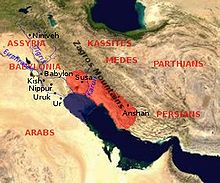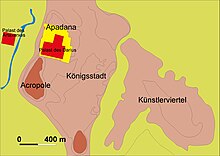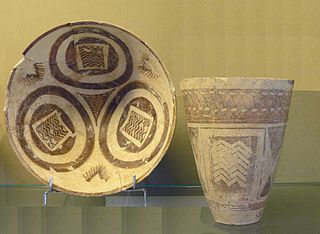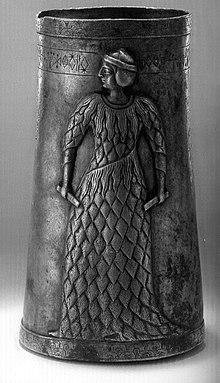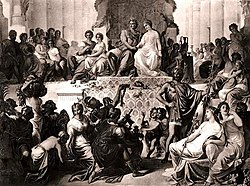Susa
Susa (Persian: شوش Shush; Hebrew: שׁוּשָׁן Shushān; Greek: Σοῦσα; Syriac: ɛɔɔ Shush; Old Persian Çūšā) was an ancient city of the proto-Elamite, Elamite, First Persian, and First Persian Empires of Iran. Seleucid and Parthian, and one of the most important cities of the Ancient Near East. It is located in the lower part of the Zagros mountains about 250 km east of the Tigris river, between the Karkheh and Dez rivers, in the southwest of present-day Iran.
Today, only a large field of ruins remains of the ancient city. The modern Iranian city of Shush stands on the site of ancient Susa. Shush is the administrative capital of the Shush county of the Khuzestan province. It had a population of 64,960 in 2005.
Name
In Elamite, the name of the city was spelled variously Ŝuŝan, Ŝuŝun, etc. and was apparently pronounced Susən. Šušan was invaded by the Babylonian and Assyrian empires in violent campaigns. The origin of the word Susa comes from the local deity Inshushinak. After the Babylonian conquest, the name was misinterpreted and related to the Semitic term šušan, 'lily'.
Literary traditions
Susa was one of the most important cities in the Ancient Near East. In historical literature, Susa appears in early Sumerian documents: for example, it is described as one of the places subject to the obedience of Inanna, Uruk's own deity, in Enmerkar and the Lord of Aratta.
Biblical texts
Susa is mentioned in the Ketuvim of the Hebrew Bible under the name Shushan, mainly in Esther, but also once in Nehemiah and Daniel. Both Daniel and Nehemiah lived in Shushan during the Babylonian captivity of the VI century BCE. C. Esther becomes queen there, by marrying King Ahasuerus, and she saves the Jews from genocide. A grave believed to belong to Daniel is located in the area, known as Shush-Daniel; however the current structure is actually a much later construction dating to the late 19th century, around 1871. Susa is mentioned again in the Book of Jubilees (8:21 & 9:2) as one of the places that were inherited by Shem and his eldest son, Elam; and in 8:1, "Susan" it also appears as the name of a son (or daughter, in some translations) of Elam.
Greek Texts
Greek mythology attributes the founding of Susa to King Memnon of Ethiopia, a character featured in Homer's epic tale of the Trojan War, the Iliad.
Excavations
The site was examined in 1836 by Sir Henry Rawlinson and later by A. H. Layard. In 1851 William Loftus made modest excavations and it was he who identified the site as Susa. In 1885 and 1886 Marcel-Auguste Dieulafoy and Jane Dieulafoy began the first French excavations.
Jacques de Morgan conducted more extensive excavations between 1897 and 1911. These efforts continued with Roland De Mecquenem until 1914, at the beginning of World War I. French work at Susa resumed after the war, led by De Mecquenem, and continued until 1940, with World War II. Archaeological results from the latter period were scarcely published and attempts are underway to remedy this situation..
Roman Ghirshman took over the leadership of the French efforts in 1946, after the end of the war. He continued there until 1967. Ghirshman concentrated on excavating only one part of the site, the so-called "Ville Royale"; ('royal city') of one hectare, going down to the bare earth. The pottery found in the various levels allowed the development of a stratigraphy for Susa.
During the 1970s, excavations were resumed under the direction of Jean Perrot.
First settlements
Susa is one of the oldest settlements in the region, probably having been founded as a village around 4000 BC. C., but archaeologists have dated the first traces of the Neolithic villa inhabited in 7000 BC. C. There is evidence of a painted ceramic civilization that has been dated to c. 5000 B.C. Early First Style Susa painted pottery vessels are a regional, late version of the Mesopotamian Obeida pottery tradition that spread throughout the Near East during the 5th millennium BCE. C.
In the history of cities, Sousse is one of the oldest known settlements in the region. Based on the C14 dating, the founding of the settlement there had to occur as early as 4395 BC. C. (a calibrated radiocarbon dating). At this stage, the city was already very large for the time, around 15 hectares.
The founding of Susa corresponded with the abandonment of nearby towns. Potts suggests that the city may have been founded in an attempt to re-establish the previously destroyed settlement of Chogha Mish. Chogha Mish was also previously a very large settlement and featured a massive platform similar to that later built at Susa.
Another major settlement in the area is Chogha Bonut, which was discovered in 1976.
Sousse I Period
Shortly after Susa was first inhabited more than six thousand years ago, its inhabitants erected a temple on a monumental platform that towered over the surrounding plain landscape. The exceptional nature of the site is still recognized today in the artistry of the ceramic vessels that were placed as offerings in a thousand or more tombs near the base of the temple platform.
The first settlement of Susa is known as the Susa I period (c. 4200-3900 BCE). Two settlements that archaeologists have named Acropolis (7 ha) and Apadana (6.3 ha), would later merge to form Susa proper (18 ha). The Apadana was enclosed in twenty-foot-wide mud walls (this particular site is called the Apadana because it also contains a later Achaemenid structure of this type).
Almost two thousand jugs in the Susa I style were recovered from the cemetery and most of them are today in the Louvre. The containers found are eloquent testimony to the artistic and technical achievements of their makers and offer clues about the organization of the society that commissioned them.
The Susa I style was largely a product of the past and of influences from contemporary ceramic industries in the mountains of western Iran. The coincidence in close association of vessels of three types—a drinking chalice, a serving plate, and a small pitcher—implies the consumption of three types of food, which were apparently needed for the afterlife in the same way that they were. in this world. Ceramics with these forms, which was painted, constituted a large proportion of the vessels in the cemetery. Others that have a coarser appearance, for cooking, jugs and bowls, with simple bands painted on them, were possibly funerary offerings for the graves of humbler citizens as well as adolescents and, perhaps, children. The pottery has been carefully made by hand.. Although a slow wheel may have been used, the asymmetry of the vessels and the irregularity of the surrounding lines and bands indicate that most of the work was done by freehand.
Copper metallurgy is also attested in this period, which was contemporary with metal works in some deposits in the highlands of Iran such as Tappeh Sialk.
Susa II and the influence of Uruk
Susa entered Uruk's sphere of cultural influence during the Uruk period. An imitation of the entire state apparatus of Uruk, proto-writing, cylinder seals with Sumerian motifs, and monumental architecture, all of which can be found in Susa. According to some scholars, Susa may have been a colony of Uruk.
There is some discussion about the comparative periodization of Susa and Uruk at this time, as well as the extent of Uruk's influence on Susa. Recent research indicates that the early Uruk period corresponds to the Shushan II period.
D. T. Potts argues that the influence of the Khuzestan region in the Iranian highlands, in Susa, was most significant in the early period and also continued later. Thus, Susa combined the influence of two cultures, that of the plateau and that of the alluvial plains. Potts also insists on the fact that the Uruk script and numbering systems were not simply borrowed wholesale from Susa; rather, a partial and selective loan was produced, which was adapted to the needs of Susa. Despite the fact that Uruk was still larger than Susa at the time, Susa was not its colony, but it still maintained some independence for a long time, according to Potts.
Some scholars believe that Susa was part of the larger Uruk culture. Holly Pittman, an art historian at the University of Pennsylvania in Philadelphia, says that "the Shusanids are fully involved in the Uruk way of life." They are not culturally distinct; the material culture of Susa is a regional variation of the Mesopotamian plain". Gilbert Stein, director of the Oriental Institute at the University of Chicago, says that "An expansion once thought to have lasted less than 200 years now apparently continued for 700 years. It is hard to think of any colonial system that lasted so long. The expansion of the Uruk material does not evidence an Uruk dominance; it may have been a local choice".
Susa III Period
Susa III (3100–2700 BCE) is also known as the "Proto-Elamite" period. Pottery from the Banesh period predominates at this time. It is also here that proto-Elamite tablets appear for the first time. Subsequently, Susa became the center of Elam's civilization.
Ambiguous references to Elam appear in Sumerian documents at this time. Susa enters history during the Archaic Dynastic period of Sumer. A battle between Kish and Susa in 2700 BC is documented. c.
Elamites
It would later become the capital of the Elamite Empire. In the Sumerian period, Susa was the capital of a state called Susiana (Šušan), which occupied roughly the same territory as the modern province of Khuzestan centered on the Karun River. Control of Susiana varied between Elam, Sumer, and the Akkadians. Susiana is sometimes confused as a synonym for Elam but, according to F. Vallat, it was a different political and cultural entity.
Susiana was incorporated by Sargon the Great into his Akkadian empire around 2330 BC. c.
Kutik-Inshushinak
Susa was the capital of an Akkadian province until around 2100 BC. C. when its governor, Kutik-Inshushinnak, rebelled and made it an independent state and a literary center. He was also the last of the Awan dynasty according to the Susa king list, he unified the neighboring territories and became king of Elam. He encouraged the use of the linear Elamite script, which remains undeciphered.
The city was later conquered by the Neo-Sumerian Ur-III dynasty and held it until Ur finally fell to the Elamites under Kindattu in around 2004 BCE. C. At this time Susa became the Elamite capital under the Epartid dynasty.
Middle Elamite Period
Around 1500 B.C. The Middle Elamite period began with the rise of the Anshanite dynasties. His government was characterized by an "elamization" of Susa, and the kings assumed the title of "king of Anshan and Susa". Whereas previously the Akkadian language was frequently used in inscriptions, later kings such as the Igihalkid dynasty of c. 1400 B.C. C., they tried to use the Elamite. Thus the Elamite language and culture grew in importance in Susiana.
This was also the time when the Elamite pantheon established itself in Susiana. This policy reached its peak with the construction of the religious and political complex of Choga Zanbil, 30 km southeast of Susa.
About the year 1175 B.C. In C.C., the Elamites under Shutruk-Nahhunte looted the original stele inscribed with the Code of Hammurabi, the world's first known written laws, and took it to Susa. Archaeologists found it in 1901. Nebuchadnezzar I of the Babylonian Empire sacked Susa around fifty years later.
Neo-Assyrians
In 647 B.C. C. the neo-Assyrian king Ashurbanipal razed the city during a war in which the people of Susa participated with the other side. A tablet unearthed in 1854 by Austen Henry Layard at Nineveh reveals Ashurbanipal as an 'avenger', seeking to make up for the humiliations the Elamites had inflicted on the Mesopotamians over the centuries:
"Susa, the great holy city, the habitation of her gods, the seat of her mysteries, I conquered her. I entered their palaces, opened their treasures where silver and gold, goods and wealth were enlarged, and... I destroyed Susa's zigurat. I crushed the brilliant copper horns. I returned to the temples of Elam to nothing; their gods and goddess, I threw them into the wind. The tombs of their kings, old and recent, I devastated them, exposed to the sun, and brought their bones to the land of Asur. I devastated the provinces of Elam and, in their lands, sowed salt. "
Assyrian rule over Susa began in 647 B.C. C. and lasted until the median capture of Susa in 617 BC. c.
After the Persian conquest
Achaemenid Period
Susa underwent a major political and ethnocultural transition when it became part of the Persian Achaemenid Empire between 540 and 539 BC. when it was captured by Cyrus the Great during his conquest of Elam (Susiana), of which Susa was the capital. The Chronicle of Nabonidus documents that, before the battles, Nabonidus had ordered statues of worship of outlying Babylonian cities, suggesting that the conflict over Susa had possibly begun in the winter of 540 BC. C.
It is likely that Cyrus negotiated with the Babylonian generals to obtain a compromise on their part and thus avoid an armed confrontation. Nabonidus was in the city at the time and soon fled to the capital Babylon, which he had not visited for years. Cyrus's conquest of Susa, and of the rest of Babylonia, began a fundamental change, bringing Susa under Persian control for the first time.
Perhaps as early as the reign of Cyrus II (c. 559-529 BC), Susa functioned as one of the capitals of the Persian Empire. But surely, under Cyrus's son Cambyses II, Susa became the political center as one of the four capitals of the Persian Achaemenid Empire, while pasargadae's importance as the capital of Persia diminished. After Cambyses' brief rule, Darius the Great began a major building program at Susa and Persepolis. At this time, he describes his new capital in the DSF inscription:
"This palace I built in Susa, has decoration brought from afar. Downward the earth was dug, until I reached the rockbed. When the excavation was finished, then the debris were piled, about 40 cubits deep, another part 20 cubits deep. The palace was built on those rubble. "
Susa remained the winter capital and residence of the Achaemenid kings who succeeded Darius the Great, Xerxes I and their successors. Xerxes I would have set out from Susa in the summer of 481 BC. C. in the direction of Critalia, in Cappadocia, to conquer Greece.
The play The Persians (472 BC) is set in the city, an Athenian tragedy by the Greek playwright Aeschylus, which is the oldest surviving play in the history of theater.
Events mentioned in the Old Testament Book of Esther are said to have occurred in Susa during the Achaemenid or Sasanian era.
Macedonian, Parthian and Sasanian Periods
Susa was conquered by Alexander the Great in 331 BC. C. with what was done with the first Persian Empire. So Susa lost much of its importance. There the so-called "weddings of Susa" were held, arranged by Alexander in 324 BC. C. in Susa, between the Macedonians and the Persians.
Roughly a century after Alexander, Susa fell into the orbit of the Seleucid Empire. After Seleucia, it was the largest city under Seleucid control at that time.[citation needed] Susa used Alexandria de Susiana (Cárace) as your port. It retained considerable independence and its organization as a Greek city-state well into the Parthian period and seems to have gained independence under a dynasty whose kings bore the name Kamnaskires in the I d. C.
When the Parthian Empire gained its independence from the Seleucid Empire and assumed control of much of its eastern provinces, Susa was made one of the two capitals (along with Ctesiphon) of the new state.
Susa was a frequent place of refuge for the Parthians and, later, the Sasanian kings of Persia, when the Romans sacked Ctesiphon five different times between AD 116 and 297. (Susa was briefly captured only by the Roman Emperor Trajan in AD 116, and never again did the advances of the Roman empire reach this far east.) Parthian rulers typically wintered in Susa and summers in Ctesiphon.
Post-Islamic period and degradation
Susa was destroyed at least three times in its history. The first was in the year 647 a. C., by Ashurbanipal. The second took place in the year 638, when Muslim armies first conquered Persia. In 1218 the city was razed to the ground by Mongol invaders. The city was further degraded in the 15th century when most of its population moved to Dezful and remained as the small settlement current.
Susa had a significant Christian population throughout the first millennium and was a diocese of the Assyrian Church of the East between the 5th and 13th centuries, in the metropolitan province of Beth Huzaye (ʿIlam or Elam) /?
World Heritage Site
In July 2015 it was inscribed on the UNESCO World Heritage List.
Contenido relacionado
Chiba (Chiba)
Hanoi
Higashimatsuyama (Saitama)
Canberra
Balkh Province
